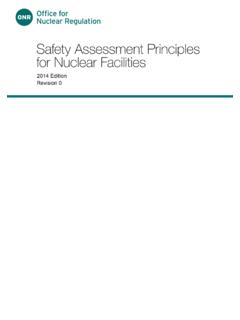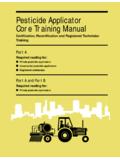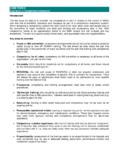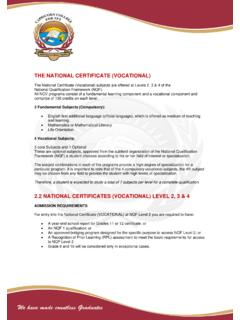Transcription of Key Concepts in Patient Safety - Jones & Bartlett …
1 1 Key Concepts in Patient SafetyKimberly A. Galt, Karen A. Paschal, and John M. Gleason1 CHAPTEROBJECTIVESA fter completing this chapter, you will be able to: Define the scope of the problem of unsafe healthcare practices inthe United States Compare and contrast the individual Patient and public viewpointabout healthcare Safety and harm Describe the historical development of the theories and practicesof Safety in industries other than health care Describe the rationale for professionals to integrate basic Concepts of Patient Safety in health care Use the basic terminology and vocabulary of Patient Safety in health care1 PURPOSEThe purpose of this chapter is to provide all health professionals with the coretheory and knowledge they need to understand and practice Patient care usingpatient Safety principles.
2 This core knowledge underpins and supports the re-maining chapters and case studies. Every chapter that follows incorporatesthese Safety 9/24/09 8:01 PM Page 1 Jones and Bartlett Publishers, LLC. NOT FOR SALE OR DISTRIBUTION. Safety AS A FOUNDATION OF HIGH-QUALITY HEALTH CAREThe Safety of a Patient depends on each health professional s ability to do theright thing. As a health professional continuously works at improving quality, in-dividual performance shifts to doing the right thing well. 1 Assuring the safetyof the Patient to whom services are provided is an essential dimension of profes-sional performance. The Institute of Medicine (IOM) published a report in 2000entitled To Err is Human: Building a Safer Health report describesthe risks of medical care in the United States and the documented harm that has2 CHAPTER1 KEYCONCEPTS INPATIENTSAFETYVIGNETTEI watched my father in the hospital bed.
3 He was trying to rise, but his muscleswere so weak that he could not sit up on his own. Although the staff had taughthim to roll over on his side and push up, he could no longer lift his upper bodywith his arms. What happened to him? I was only 13 years old at the time. Mydad had been in the hospital for over 2 years but still kept losing weight. The doc-tors could not find the correct diagnosis. When entering the hospital, he was a tallman of 6'4" who weighed 195 pounds, but he weighed only 125 pounds at dis-charge. He was tested for all kinds of cancer and was referred for extensive psy-chological testing. He was accused of starving himself. He had supervised feedingsand extensive counseling. Self-insured as a small business owner, my father s re-sources were drained, and there was no way to continue to pay for services.
4 Onthe day that he was discharged, a medical bill for $350,000 was handed to mymom. Dad s hair was sparse and his eye color faded. He was starving to death. Hewent home expecting to die. My mom started reading on her own. She learnedabout a problem with gluten absorption. Later we made a diagnosis of celiac dis-ease. She took action and obtained years later, I learned about parenteral nutrition in pharmacy school. Whywas Dad s nutrition not maintained by this means? Missed diagnoses they mustbe common. How could 2 years of testing overlook what my mom could find? Myfather was now a man with permanent neurologic disabilities secondary to severemalnutrition, and my family was financially insolvent. After money was no longeravailable, Dad was abandoned. For what were all of those resources used?
5 The im-pact of unsafe health care caused by a medical error is very real to my 9/24/09 8:01 PM Page 2 Jones and Bartlett Publishers, LLC. NOT FOR SALE OR DISTRIBUTION. occurred because of unsafe practices in the healthcare is a safe pa-tient practice? A Patient Safety practice is a type of process or structure whose ap-plication reduces the probability of adverse events resulting from exposure to thehealthcare system across a range of diseases and care we deliverand the way we deliver it should have the least potential to cause Patient harm andthe greatest potential to result in an optimal outcome for the Patient . patients as-sume that this is what we do when we take care of CASE FOR IMPROVING Patient SAFETYU nsafe Practices: The Scope of the Problem of Errors in Health CareThe IOM has summarized the evidence about medical errors in the United evidence estimates that up to 98,000 individuals die every year in hospitalsas a result of medical errors and that 2% of hospitalized patients experience a pre-ventable adverse event.
6 Sufficient numbers of these events result in serious of the most common errors include improper transfusions, surgical in-juries and wrong-site surgery, suicides, restraint-related injuries or death, falls,burns, pressure ulcers, misdiagnoses, and mistaken Patient identities. Some of themost frequent errors occur in the most intensive care environments, such as emer-gency rooms, operating rooms, and intensive care units. On the other hand, themajority of care is provided in outpatient and ambulatory areas, an environmentthat has been described as a nonsystem. Care is provided without complete accessto medical information about patients ; often multiple providers serve different as-pects of a Patient s care needs, and the emphasis on accountability and reportingis nearly medical liability system is also regarded as a major disincentive to opendisclosure of information about errors.
7 The impact has been to discourage theTHECASE FORIMPROVINGPATIENTSAFETY3i More recent reports have been published that inform us further about additional andemerging problems in Safety and our progress in addressing these causes. For example, a 2006report entitled Medication Errors by the Committee on Identifying and Preventing MedicationErrors Board on Health Care Serviceswas released. It focuses more deeply on problems withmedications. These reports can be accessed through the Institute of Medicine website( ). A lifelong practice of staying informed as these sentinel reports arepublished is vital to maintaining professional knowledge and evolving science and evidencein Patient Safety and professional 9/24/09 8:01 PM Page 3 Jones and Bartlett Publishers, LLC.
8 NOT FOR SALE OR DISTRIBUTION. systematic study of uncovering causes and learning how to change what we dofrom our errors. Many healthcare providers fear costly law suits or loss of employ-ment and other harm that can occur to those who are involved in errors or unsafepractices. Many anecdotal reports of employment termination exist because ofan individual s unfortunate involvement in a medical error. In a recent study ofemployees who work in physicians offices, 24% of the offices reported that anindividual has been dismissed from employment because of a medical error thatoccurred in that office. Not surprisingly, only 65% of the offices reported that theycan openly discuss lack of cooperation and perceived risk of disclo-sure discourage healthcare providers, organizations, and payers, often third party,from openly discussing and investing in the improvements needed to achieve asafer, higher quality healthcare Real Problem Is Harm, Not ErrorsThe harm that occurs is impressive when the financial, resource utilization, andhealthcare system impact is evaluated; however, the immeasurable costs are re-flected in the life experiences of the patients who are harmed and their loved onesand friends.
9 This is clear in the stories of our authors. Fear and distrust of the healthsystem and the individual health professionals who serve emerge as the dominantbelief system for patients . The repercussions of harm are both physical and psy-chological. Often there is no reversing of the damages. The permanency of injuriesis a constant reminder of the harm. A health professional s confidence, enthusi-asm, and desire to serve in this capacity are explicitly challenged when dealingwith these situations. Thus, this touches Is to Blame?This common question always arises after an error occurs. It strikes fear, guilt,anger, and the desire for restitution or even revenge from some. These feelingsemerge in both patients and family members, as well as in the professionals in-volved.
10 It is too easy to blame an individual, such as a healthcare provider or healthsystem employee, making the one person wholly responsible for the complex andoften inadequate health systemin which most of us work. The lack of integrationof clinical decision support systems, the paucity of training in Patient Safety forprofessionals, and the lack of organizational leadership to achieve safer systems allcontribute to each of the errors that get compounding this challenge is the cultural and social context. Afterharm occurs, the individuals directly involved become isolated. Because the unsafe4 CHAPTER1 KEYCONCEPTS 9/24/09 8:01 PM Page 4 Jones and Bartlett Publishers, LLC. NOT FOR SALE OR DISTRIBUTION. event usually happens to one person, one episode at a time, a critical mass of per-sons who are simultaneously having the experience does not exist.
















